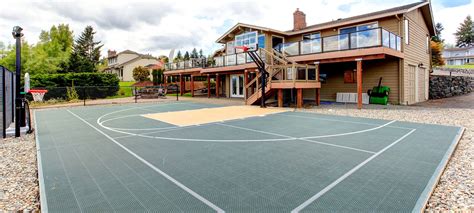Transform Your Backyard: Build a Tennis Court
Building a tennis court in your backyard might seem like a daunting task, but with careful planning and execution, it can become a reality. This comprehensive guide will walk you through every step, from initial planning to the final touches, ensuring you end up with a stunning and functional tennis court perfect for recreational play or serious matches.
What are the Different Types of Tennis Court Surfaces?
Choosing the right surface is crucial. Each type offers different playing characteristics and maintenance requirements. The most common types include:
- Hard Courts: These are typically made of asphalt or concrete, offering a fast, predictable playing surface. They are durable and relatively low-maintenance but can be harder on joints.
- Clay Courts: Known for their slower pace, clay courts provide a more forgiving surface, reducing stress on the body. They require more maintenance, including regular watering and grooming.
- Grass Courts: These traditional courts offer a unique playing experience, with a faster pace than clay but slower than hard courts. They are the most demanding in terms of maintenance, requiring regular mowing, rolling, and watering.
How Much Does it Cost to Build a Tennis Court?
The cost of building a tennis court varies significantly depending on several factors:
- Surface type: Clay courts are generally the most expensive to build, followed by grass courts, then hard courts.
- Location: Labor and material costs differ regionally.
- Size and features: Standard court dimensions are required, but additional features like fencing, lighting, and landscaping will impact the overall cost.
- Drainage: Proper drainage is essential, and its complexity will affect cost.
Expect to invest anywhere from $10,000 to $50,000 or more. Getting multiple quotes from reputable contractors is essential for accurate budgeting.
What Permits and Approvals Do I Need?
Before you break ground, check with your local authorities. You will likely need building permits, possibly zoning approvals, and potentially HOA approvals (if applicable). Failure to obtain necessary permits can result in significant fines and delays.
How Long Does it Take to Build a Tennis Court?
Construction time depends on the size and complexity of the project, weather conditions, and contractor availability. Expect the process to take anywhere from a few weeks to several months.
What are the Ongoing Maintenance Requirements?
Once built, your tennis court will require ongoing maintenance to maintain its quality and playability. This includes:
- Regular cleaning: Removing debris and leaves.
- Surface maintenance: Depending on the surface type, this might involve sweeping, watering, rolling, or resurfacing.
- Net and fence repair: Addressing any damage or wear and tear.
Can I Build a Tennis Court Myself?
While technically possible, building a tennis court is a complex undertaking requiring specialized skills and equipment. Unless you have significant experience in construction, landscaping, and tennis court building, it’s strongly recommended to hire a professional contractor.
What are the Benefits of Having a Private Tennis Court?
Beyond the obvious recreational advantages, a private tennis court offers several benefits:
- Increased property value: A well-maintained tennis court can significantly increase your home's market value.
- Enhanced lifestyle: Enjoy convenient access to exercise and recreation right in your backyard.
- Family fun: Create lasting memories with family and friends.
Conclusion: Your Dream Court Awaits!
Building a tennis court in your backyard is an investment that offers significant returns in terms of enjoyment, property value, and lifestyle enhancement. By carefully planning, selecting the right contractor, and understanding the maintenance requirements, you can transform your backyard into your very own private tennis paradise. Remember to prioritize thorough research and professional guidance to ensure a successful and rewarding project.

